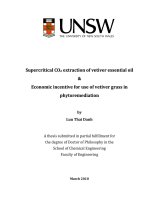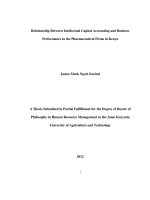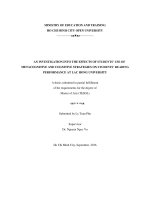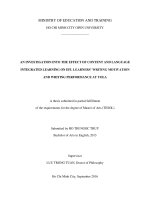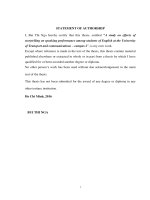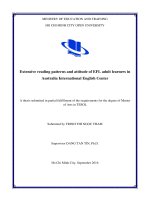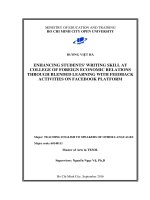Lectures and students evaluations on the coursebook international express pre intermediate second edition a thesis submitted in partial fulfillment of the requirements for the degree of
Bạn đang xem bản rút gọn của tài liệu. Xem và tải ngay bản đầy đủ của tài liệu tại đây (1.52 MB, 192 trang )
MINISTRY OF EDUCATION AND TRAINING
HO CHI MINH CITY OPEN UNIVERSITY
------------------------------------------
NGUYỄN NGỌC BẢO CHÂU
LECTURERS’ AND STUDENTS’ EVALUATIONS
ON THE COURSEBOOK INTERNATIONAL EXPRESS
PRE-INTERMEDIATE – SECOND EDITION
Major: TEACHING ENGLISH TO SPEAKERS OF OTHER LANGUAGES
Major code: 60140111
MASTER OF ARTS IN TESOL
Supervisor: Assoc. Prof. Dr. PHAM VU PHI HO
HO CHI MINH City, 2016
STATEMENT OF AUTHORSHIP
I certify that this thesis entitled “Lecturers’ and Students’ Evaluation on the
coursebook International Express – Pre-intermediate - Second Edition” is my own
work.
Except where reference is made in the text of the thesis, this thesis does not contain
material published elsewhere or extracted in whole or in part from a thesis by which
I have qualified for or been awarded another degree or diploma.
No other person’s work has been used without due acknowledgement in the main
text of the thesis.
This thesis has not been submitted for the award of any degree or diploma in any
other tertiary institution.
Ho Chi Minh City, 2016
Nguyen Ngoc Bao Chau
i
RETENTION AND USE OF THE THESIS
I hereby stated that, I, Nguyen Ngoc Bao Chau, being the candidate for the degree
of Master of TESOL, accept the requirements of the University relating to the
retention and use of Master’ Thesis deposited in the Library.
In terms of these conditions, I agree that the original of my thesis deposited in the
Library should be accessible for the purposes of study and research, in accordance
with the normal conditions established bu the Library for care, loan, or reproduction
of thesis.
Ho Chi Minh City, 2016
Nguyen Ngoc Bao Chau
ii
ACKNOWLEDGEMENTS
First of all, I would like to express my appreciation to my first thesis
supervisor Dr. Nguyen Thi Boi Hoang for her guidance, sincere advice and
encouragement from the beginning of thesis progression. However, because of
some objective reasons, she left Vietnam since the middle of 2015 and could not
continuously support me to the end.
In addition, my deepest gratitude goes to my present thesis supervisor, Dr.
Pham Vu Phi Ho, who provided me invaluable thoughtful comments, and helpful
instruction on how to conduct an effective thesis writing. Without his support and
wholehearted guidance, I could not have finished my thesis.
Next, I am also grateful to all lecturers for their helpful instruction during the
Master course as well as the staff of Graduate School, at Ho Chi Minh City Open
University, for their kindly assistance.
My honest thanks go to Ms. Ngo Thi Thanh Van, The Director of TOEIC
Center, Ton Duc Thang University for her support and all the colleagues who are
the lecturers of English language at TOEIC Center, as well as students at Ton Duc
Thang University, for their contribution, enthusiastic engagement in the survey and
interviews.
I would like to thank my classmates of TESOL 7 who provide me a number
of sincere advice and share with me a lot of knowledge and learning experience
during the course. Without their helps, I think I could have never been completed
the courses.
Last but not least, I would like to express my gratitude to my family for their
spiritual as well as material supports, especially, my husband who has supported me
a great deal in conducting a thesis study.
iii
ABSTRACT
Textbooks play a vital role in language teaching program. A textbook may
serve as a main tool for teacher to convey language knowledge to EFL learners.
Nevertheless, it is obvious that no textbook can perfectly suit a language teaching
context as well as fit learners’ needs and interests. Therefore, many theorists have
developed checklists and principles for textbook evaluation.
The present study aims at evaluating coursebook International Express –
Pre-intermediate - Second Edition, used at TOEIC Center, Ton Duc Thang
University. The purpose of this study is to investigate lecturers’ and students’s
perception toward this coursebook. 304 students and 50 lecturers comprising males
and females participated in this study. The instrument employed in the study was a
textbook evaluation questionnaire adapted and modified from a variety checklist
and a semi-structured interviews with ten lecturers and ten students. The 45
questionnaire items using 5-point Likert scale rating from “1=not al all” to “5=very
much” was employed to elicit participants’ evaluation on four main categories of
the coursebook including Content, Tasks and activities, Layout and design as well
as Overall assessment.
Descriptive statistics was carried out to interpret the quantitative data by
utilizing mean and standard deviation. The quantitative data from the interview
were transcribed and grouped into themes for interpretation. The findings showed
that most lecturers and students have similar opinions with regard to the strengths
and weaknesses of the coursebook. Regarding the positive features, the finding
indicated that the layout and design of the coursebook are effective organized for a
convenience of use. Furthermore, the grammar is contextualized in meaningful
context for learners to work out rules. Last but not least, the reading and listening
texts are almost taken form authentic source to help students relate the language in
real world context.
iv
Despite the strong points, the coursebook also have some weaknesses. First
and foremost, the topics in coursebook are not diverse, up-to-date and interesting to
appeal students’ interest. Next, listening and reading texts are too lengthy and often
accompanied with challenging tasks. Moreover, tasks are not effective in terms of
provide students with opportunities to produce meaningful practice or relate the
language they acquire to their real life. In addition, the supplementary materials
inadequately support lecturers and students in teaching and learning process.
Finally, the coursebook does not really correspond to the goal and objectives of
learning courses.
Based on the finding, it is suggested that lecturers should make a great deal
of modification to make the lessons more interesting and appropriate to learner
needs and levels. Overall, the coursebook did not serve both learners’ needs and the
course goal; therefore, the educators or curriculum developers should consider
changing another coursebook more suitable to satisfy learners’ needs.
v
TABLE OF CONTENTS
STATEMENT OF AUTHORSHIP ............................................................................ i
RETENTION AND USE OF THE THESIS.............................................................. ii
ACKNOWLEDGEMENTS ...................................................................................... iii
ABSTRACT .............................................................................................................. iv
TABLE OF CONTENTS .......................................................................................... vi
LIST OF FIGURES.....................................................................................................x
LIST OF TABLES .................................................................................................... xi
LIST OF ABBREVIATIONS .................................................................................. xii
CHAPTER 1 - INTRODUCTION ..............................................................................1
1.1 Background of the study .......................................................................................1
1.2 Statement of the problem ......................................................................................4
1.3 Aims of the study and Research Questions ...........................................................8
1.4 Significance of the study .......................................................................................9
1.5 Overview of thesis chapter ....................................................................................9
CHAPTER 2 – LITERATURE REVIEW ................................................................10
2.1 Textbooks, coursebooks and instructional materials ..........................................10
2.1.1 Definitions of terms ......................................................................................10
2.1.2. The roles of coursebook in English language classroom ............................12
2.1.3. The pros and cons of coursebook ................................................................13
2.2 Coursebook evaluation ........................................................................................15
2.2.1. Definition of coursebook evaluation ...........................................................15
2.2.2 The rationale for coursebook evaluation ......................................................16
2.2.3 Types of coursebook evaluation ...................................................................18
2.3. Theoretical framework for coursebook evaluation ............................................19
2.3.1 Language Content .........................................................................................21
2.3.1.1 Topic .......................................................................................................21
2.3.1.2 Linguistic aspects ...................................................................................22
2.3.1.3 Language skills .......................................................................................24
vi
2.3.1.4 Language functions ................................................................................26
2.3.2 Tasks and Activities ......................................................................................27
2.3.3 Layout and Design ........................................................................................31
2.3.4 Overall Assessments .....................................................................................32
2.4 Review of previous studies .................................................................................34
2.4.1 Relevant studies on coursebook evaluation ..................................................34
2.4.2 Implication of the current study....................................................................47
CHAPTER 3: METHODOLOGY ............................................................................48
3.1 Pedagogical setting and Participants ...................................................................48
3.1.1 Pedagogical setting .......................................................................................48
3.1.2 Participants....................................................................................................49
3.1.2.1 Lecturers .................................................................................................49
3.1.2.2 Students ..................................................................................................50
3.2 Research method .................................................................................................52
3.3 The coursebook International Express – pre-intermediate, second edition and
learning outcomes of the course Communicative English 1 and 2 ...........................53
3.3.1 The coursebook International Express – pre-intermediate, second edition ..53
3.3.2 Learning outcomes of the course Communicative English 1 and 2 .............55
3.4 Instruments ..........................................................................................................55
3.4.1 Questionnaires ..............................................................................................56
3.4.2 Interviews......................................................................................................64
3.5 Procedures of data collection ..............................................................................65
3.5.1 Procedure of administrating the questionnaires............................................65
3.5.1.1 Administration of the questionnaires to lecturers: .................................66
3.5.1.2 Administration of the questionnaires to students: ..................................66
3.5.2 Procedure of conducting interviews .............................................................67
3.5.2.1 Lecturers’ interview ...............................................................................68
3.5.2.2 Students’ interview .................................................................................68
3.6 Data analyses .......................................................................................................69
3.6.1 Analyses of data from the questionnaire ......................................................69
3.6.2 Analyses of data from the interviews ...........................................................70
vii
3.7 Summary of the chapter ......................................................................................71
CHAPTER 4: FINDINGS AND DISCUSSION ......................................................72
4.1 Demographic profile of participants ...................................................................72
4.2 Lecturers’ and students’ perceptions towards the coursebook International
Express ......................................................................................................................75
4.2.1 Research question 1: .....................................................................................75
4.2.1.1 Evaluation on the content provided in the coursebook ..........................77
4.2.1.2 Evaluation on Tasks and activities provided in the coursebook ............91
4.2.1.3 Evaluation on Layout and design of the coursebook .............................95
4.2.1.4 Overall assessments of the coursebook ..................................................98
4.2.2 Research question 2: ...................................................................................115
4.2.2.1 Lecturers’ responses on aspects of the coursebook that need improving
..........................................................................................................................116
4.2.2.2 Students’ responses on aspects of the coursebook that need improving
..........................................................................................................................121
CHAPTER 5: CONCLUSIONS .............................................................................123
5.1 Summary of the findings. ..................................................................................123
5.1.1 Research question 1 ....................................................................................123
5.1.2 Research question 2 ....................................................................................125
5.2 Implication of the current study ........................................................................126
5.3 Limitations of the study ....................................................................................126
5.4 Recommendations for further research .............................................................127
REFERENCES ........................................................................................................128
APPENDICES.........................................................................................................133
APPENDIX 1 - INFORMATION SHEET AND CONSENT FORM FOR
LECTURERS ..........................................................................................................134
APPENDIX 2 - INFORMATION SHEET AND CONSENT FORM FOR
STUDENTS ............................................................................................................137
APPENDIX 3 - SURVEY QUESTIONAIRRE FOR COURSEBOOK
EVALUATION .......................................................................................................140
APPENDIX 4 - SURVEY QUESTIONAIRRE FOR LECTURERS .....................146
viii
APPENDIX 5 - SURVEY QUESTIONNAIRE FOR STUDENTS .......................151
APPENDIX 6 - INTERVIEW QUESTIONS FOR STUDENTS ...........................157
APPENDIX 7 - INTERVIEW QUESTIONS FOR LECTURERS ........................157
APPENDIX 8 - SUMMARY OF INTERVIEWS WITH LECTURERS ...............158
APPENDIX 9 - SUMMARY OF INTERVIEW WITH STUDENTS ....................173
ix
LIST OF FIGURES
Figure 2.1. Theoretical framework for an evaluation of the coursebook International
Express ......................................................................................................................34
Figure 3.1: Layout of a one-page questionnaire showing the placement of
demographic information, closes-ended items and open-ended items (Griffee,
2012p. 137) ...............................................................................................................59
x
LIST OF TABLES
Table 3.1: Reliability analysis of scales ....................................................................63
Table 4.1. Demographic Profile of the Lecturers......................................................72
Table 4.2. Demographic Profile of Students. ............................................................74
Table 4.3. Evaluation on the topics ...........................................................................78
Table 4.4. Evaluation on grammar ............................................................................82
Table 4.5. Evaluation on vocabulary ........................................................................84
Table 4.6. Evaluation on pronunciation ....................................................................85
Table 4.7. Evaluation on language skills ..................................................................88
Table 4.8. Evaluation on language functions ............................................................90
Table 4.9. Evaluation on tasks and activities ............................................................92
Table 4.10. Evaluation on layout and design ............................................................96
Table 4.11. Overall assessments on the coursebook .................................................98
Table 4.12. Comparison of lecturers’ and students’ evaluation on the content of the
coursebook ..............................................................................................................101
Table 4.13. Comparison of lecturers’ and students’ evaluation on tasks/ activities
and supplementary materials. ..................................................................................106
Table 4.14. Lecturers’ and students’ responses to the coverage of linguistic aspects
.................................................................................................................................109
Table 4.15. Lecturers’ and students’ responses to the coverage of language skills 111
Table 4.16. Evaluation on the design of teaching- skills methods..........................113
Table 4.17. Lecturers’ and students’ preference of teaching-skills methods ..........113
Table 4.18. Evaluation on the inclusion of the vocabulary list or glossary ...........114
Table 4.19. Assessment of aspects in the coursebook that need improving ...........116
xi
LIST OF ABBREVIATIONS
CE: Communicative English
EFT: English as a Foreign Language
ELT: English Language Teaching
ESP: English for Specific Purposes
IE: International Express
TTC: TOEIC Center
TDTU: Ton Duc Thang University
xii
CHAPTER 1 - INTRODUCTION
1.1 Background of the study
The demand of learning English in Vietnam has become more popular and
important, especially, when the country join the World Trade Organization. At the
time, Vietnamese people learn English for a variety of purposes. They acquire a
language other than their mother tongue for their interests, the need of
communication, and for self-promotion, especially, to university students, they learn
in order to pass the high-school graduation exam and entrance university exam as;
they also learn English because of their job requirements, and so on.
With such a great need, the selection of an appropriate English coursebook
for teaching and learning is not any easier for educators, syllabus designers or
curriculum developers. Tok (2010) cites that textbooks play a prominent role in the
teaching /learning process and they are the primary agents of conveying the
knowledge to the learners. Besides, one of the basic functions of textbooks is to
make the existence knowledge available and apparent to the learner in a selected,
easy and organized way.
Today there are a wide range of different off-the-shelf English language
teaching coursebooks published, thus teachers should find the one the best suitable
the learners’ needs and goals (Frendo, 2005). In addition, Bao Dat (2008) reveals
that teachers of English in Vietnam taking part in his interviews could list 37 titles
from Oxford and Cambridge publisher alone. In fact, walking along some
bookstores, people can easily find a great deal of English coursebooks for variety of
English learners at every level from beginner to advance. Therefore, the question of
how to choose a good coursebook for each language learning course asks educators
and syllabus designers to take a thorough and consideration assessment. As
proposed by Harmer (2007), a good coursebook is prepared to provide a coherent
syllabus, appropriate language control, motivating texts, audio cassetts/ CDs, video/
1
DVD material, CD-ROMs and other supplementary materials. Besides, they reduce
teachers’ time and pressure for preparing the lesson. Moreover, the teacher’s guides
not only provide the procedures for each lesson but also design extra activities,
tasks and offer other resources.
There are generally two ways to select a coursebook. First, it is chosen by
collecting ideas of a group of teachers and students after they have highlighted all
the strengths and weaknesses of some possible books as well as the needs of
learners to ensure the coursebook could match their needs. The second one,
however, is a more common way in which teachers or the school/ institute do the
selection for their learners themselves (Frendo, 2005). Consequently, when the
needs and interests of learners are not highlighted in textbook selection progress,
learners may feel demotivated and uninteresting in language learning program. In
this regards, Tomlinson (2013b) stresses that in materials selection process, the
most important thing need executing is analyzing learner needs and interests as well
as considering the way these factors are addressed. Similarly, Dang Tieu Yen
(2005) also argues that choosing a material from a wide range of sources should be
based on its curricular framework and students’ interests. In addition, Garinger
(2012) presents that “prior to selecting a textbook, educators should thoroughly
examine the program curriculum. If the goals and curriculum of the program are
clear and well defined, the parallels with certain textbooks may become obvious”.
Despites the fact that textbook plays a prominent role in ELT context, it is
believed that no textbook is perfect (William, 1983; Sheldon, 1988). Likewise,
Richards (2006, p. 257) also claims that “no commercial textbook will ever be
perfect for a language program”. Because no textbook can fully satisfy all teachinglearning contexts, it is advisable for educators or syllabus designers to do an
evaluation, in order to assess their suitability and relevance for a particular group of
learners. To do so, teachers should engage their learners’ as well as colleagues’ in
the process of selection and evaluation to obtain their attitudes and perceptions
2
towards the coursebook. According to Ansary and Babaii (2002) teachers, students,
and administers are all consumers of textbooks; thus all three groups may have
different points of view about what a good or standard textbook is. In this regards,
Richards (2006) suggests that one should consider the three main factors before
evaluating one coursebook: (i) the role of the textbook in the program, (ii) the
teachers in the program, and (iii) the learners in the program.
As indicated by Zohrabi, Sabouri and Behroozian (2012), “the basic purpose
of evaluation in school is to bring about quality improvement in education by
providing feedback regarding pupils learning, classroom teaching, appropriateness
of curriculum and course content”. In general, to make teaching and learning
successfully and effectively, educators must be aware of the objectives of the
curriculum as well as learners’ needs in the program. Consequently, obtaining
teachers’ and learners’ attitudes provides a very useful source of information for
both administrators and teacher themselves to adapt the textbooks flexibly and
successfully so that teachers can improve their teaching and learners’ learning.
Although there are no consensus on these checklists, they generally propose
framework, guidance and criticism for an in-depth judgement the language teaching
materials. In addition, many authors and researchers have applied these proposals
for evaluating coursebook.
Riasati and Zare (2010) conducted a study on EFL Teachers’ Perspectives on
“New Interchange” by using Litz (2005)’s checklist and concluded that most
teachers have similar opinions with regard to the effectiveness and suitability of the
series. Tok (2010) evaluated the advantages and disadvantages of “Spot On” and
claimed that negative attributes far out-weighed the positive characteristics.
Haghverdi and Gahsemi (2012) conducted an a study on textbook evaluation to
explore pedagogic values of “American English File” and indicated that both
experts and teachers agreed that the course book series are in alignment with the
goals presented by its authors. Al-sowat (2012) evaluated textbook "Say It In
3
English" by using a questionnaire adapted from many checklists and showed that
there were statistically significant differences between the views of male and female
teachers referred to gender in favor of female teachers. Ahour and Ahmadi (2012)
conducted a study to evaluate textbook “Summit 2B” with both teachers and
students by employing Doaud and Celce-Murcia (1979)’s checklist and indicated
that there are some problems related to the criteria of vocabulary and structure, and
physical make-up in relation to the over-loaded pages.
In Vietnamese ELT context, studies conducted on coursebook evaluation are
quite limited. Nguyen Thi Thuy Minh (2007) evaluated a new series of English
textbooks including English 10, English 11, and English 12 developed by the
Ministry of Education and Training of Vietnam (MOET) by applying
Cunningsworth (1995)’s checklists and concluded that shortcomings might have
made the books less communicative than they would have been expected and
intended to be. Similarly, Le Hoang Kim (2011) also used Cunningsworth (1995)’s
checklist to evaluate an ESP coursebook used for students majoring in accounting,
financing, and banking at Ho Chi Minh City Open University and revealed that the
book does not match learner needs and level, and it should be replaced by another
course book that can meet learner needs. In addition, Tran Thi Kim Trang (2013)
employed Huchinson and Waters (1987)’s framework an evaluation of
Pharmaceutical English Textbook at Phuong Nam Vocational College and
illustrated that the textbook does not fit learner needs and contains several limitation
that need improving.
1.2 Statement of the problem
First, it is widely seen that most of the instructional materials in the program
are recommended textbooks and chosen in accordance with the requirement of the
university teaching plan (Duong, 2005). She also documents that textbooks are
almost written by native English speakers for EFL learners and this results in large
4
gaps between the materials written and the actual needs of learners and teachers.
According to a confidential research project conducted for a major publisher,
Tomlinson (2008, p. 3) presents that “many English language teaching materials are
designed for teaching English rather than for learning it”. He also clarifies that ELT
materials presently is one of contribution to the failure of ESL and EFL leaners
because they primarily focus on the teaching of language items rather than on the
provision of opportunities for language acquisition and development.
Second, the issue of developing ELT materials is especially concerned by
Tomlinson (2013a) when there have been a numerous of materials published
recently. He reveals that almost experienced writers depend on their intuitions about
what they believe useful and necessary and provide the content and activities in
their repertoire that is supposed to match their objectives, but the theories of
language teaching and learning or principle of materials development. In addition,
Richard (2006) also reveals that the development of commercial textbook is
frequently affected by the interest of either authors or publisher.
The author is generally hopeful that the book will be successful and make a
financial profit because a large investment of the author’s personal time and effort
is involved. The publisher is primarily motivated by financial success. However, in
order to achieve a profit, publishers generally recognize that a book must have
qualities of excellent that will distinguish it from its competitors (Richard, 2006, p.
257).
Due to restrictions of coursebook development, “doing an objective
evaluation and gathering feedback may help the decision-making process the next
time a course in run. This evaluation should take into account both the teacher’s and
learners’ perspectives” (Frendo, 2005, p. 46). Today, most teachers or curriculum
developers, however, originally evaluate the coursebook they are about to used or
being used intuitively; they can figure the merits and demerits of the coursebook
without doing any assessment. In fact, since textbook are an essential component in
5
language teaching, and no textbook can fully satisfy the teaching requirement in all
context, it is important to subject the textbooks in use to evaluation, in order to
assess their suitability and relevance for a particular group of leaners in a specific
ELT context.
Third, in Vietnam ELT context, the field of textbook evaluation so far is
under-researched while the industry of ELT materials publishing is growing
dramatically. Moreover, ELT materials have rarely selected with a consideration of
learner needs and interests before a course starts. Instead, the school or institutions
tend to choose a coursebook they believe appropriate and can serve learner needs
without doing an evaluation.
Moreover, with regards to the coursebooks International Express, they have
been widely using in some English language centers and universities in Vietnam.
For instance, by 2015, Center for Foreign Language of Ho Chi Minh city University
of Pedagogy and Hanoi University of Science and Technology had used the
coursebooks
International
Express
for
classes
of
General
English
and
Communicative English. Cao Thang College of Technology has also been using
International Express for their ELT programs. Although the series of coursebook
International Express have been used popularly, there were few studies conducted
to evaluate this series as well as to investigate the perceptions of teachers and
learners using them.
Similarly, at Ton Duc Thang University (TDTU), since TOEIC Center
(TTC) was founded in 2011, the series of coursebook International Express Second Edition including levels of Elementary, Pre-intermediate and Intermediate
(Keith Harding and Liz Taylor, 2005) have been using in the course of
Communicative English for students of all majors except for those majoring in
English and Chinese-English. Nevertheless, there had not been any evaluation
conducted at TDTU to examine the strong and weak points of International Express
or to acquire lecturers and learners’ perceptions before.
6
In addition, in 2014, after about 1 year teaching at TTC, the researcher had
noticed there were a number of complaints from lecturers and learners on the
coursebook International Express – New Edition regarding its content such as
lengthy and difficult listening texts, too much vocabulary and uninteresting topics,
and so on. Moreover, students attending these courses were not really motivated
and interested in English language learning. In fact, they were usually absent from
classes as much as they can and inattentive in learning. With regard to this issue, the
researcher assumed that the content of training program or the materials perhaps
were not appropriate to what students expected in an English language course.
Therefore, the researcher conducted some short personal communications with
lecturers and students overhere to get their general ideas towards the coursebook in
use.
It was revealed that most students and lecturers agreed the coursebook
International Express are more suitable with adults or working people who already
have experience and skills in doing business rather than students at university level.
In addition, experienced lecturers also presents that though students can achieve the
required scores of TOEIC test and pass their training course, they remained unable
to apply linguistics knowledge and skills, especially speaking and writing skills into
real life communication on a daily basis. Lecturers and students assumed that
language of the coursebook is higher than their English language proficiency and
the cultural content is far different from Vietnamese culture, thus they were not
really inspiring to get students involved in the lessons. In addition, lecturers showed
that since they were not given any teacher’s book, they could not exploit the
coursebook effectively with more extra activities, useful instructions and
techniques.
Thus, to fill the gap in this field, this study was conducted in an attempt to
explore lecturers’ and learners’ evaluation towards the coursebook International
Express – pre- intermediate as well as to examine the appropriate of the book in
accordance with learner needs and the learning outcomes of the course. This
7
objective evaluation was based on the responses of users towards four main
categories: Content including Topic, Linguistic aspects, Language skills, and
Language functions; Tasks and Activities; Layout and Design as well as Overall
Assessments. The present study hopefully can acquire some recommendations for
an improvement of the coursebooks in order meet learn needs and interests in
teaching context at TDTU.
It should be clarified that after the researcher decided to conduct this
evaluation, TOEIC Center have made some changes in coursebook selection.
Particularly, the coursebooks of level elementary and intermediate were replaced by
other EFL coursebooks. Nevertheless, until now, the coursebook International
Express – pre-intermediate has been being used for teaching classes of
Communicative English 1 and 2.
1.3 Aims of the study and Research Questions
The primary concern of the present study was to investigate perceptions of
lecturers and learners towards the coursebook International Express - preintermediate regarding it Content; Tasks and Activities; Layout and Design as well
as Overall Assessments. In addition, shortcomings of coursebooks International
Express was investigated in accordance with learner needs and interests. Last but
not least, the study tried to explore useful recommendations to improve the quality
of English training at TDTU.
To this end, the study aimed to seek the possible answers for the following
research questions:
1. What are lecturers’ and students’ perceptions towards the coursebook
International Express – pre-intermediate employed at TOEIC Center, TDTD?
2. Which aspects in the coursebook need improving to meet learner needs
and interests?
8
1.4 Significance of the study
The findings of the study may help both the administrators, and teachers
have an overview of the strengths and weaknesses of the coursebook International
Express so that they can adapt the books more effectively in their educational
setting and to meet the objectives of the course and learners’ needs. Consequently,
the results might be beneficial for all users including lecturers and students, as well
as the curriculum developers, policy makers in selecting or developing an ELT
coursebook. Last but not least, the study is expected to make a little contribution to
the field of evaluating ELT materials in Vietnamese context.
1.5 Overview of thesis chapter
The thesis study consists of five chapter. Chapter one aims at introducing the
background of study as well as the rationale, purposes for conducting the study. In
this chapter, the two research questions which the study set out to answer was also
addressed. Chapter two aims to provide a theoretical framework for an evaluation of
coursebooks together with the reviews of previous studies in textbook evaluation.
Chapter three presents pedagogical setting, samples, the methods, the instruments
for collecting the data to answer the research questions. Next, chapter four appears
to present the results and interpretation in relation to the research questions. Finally,
chapter five occurs to summarize the findings based on the results of previous
chapter, along with the implication and some recommendation for further research.
9
CHAPTER 2 – LITERATURE REVIEW
This chapter aimed at providing a critical review and analysis of the
literature relevant to coursebook evaluation. To this end, the researcher defined
some concepts of coursebook, coursebook evaluation, as well as summarized roles,
advantages and disadvantaged of coursebook in ELT context. Additionally, the
importance and types of coursebook evaluation were presented in relation to the
present study. Moreover, the conceptual framework as well as criteria for evaluating
coursebook was addressed in this chapter. Last but not least, in order to examine the
gap and similarities as well as differences in previous research, the literature of
relevant studies was also reviewed in latter part of this chapter.
2.1 Textbooks, coursebooks and instructional materials
2.1.1 Definitions of terms
Textbook is “a book on a specific subject used as a teaching learning guide,
especially in a school or college. Textbooks for foreign language learning are often
part of a graded series covering multiple skills (listening, reading, writing, speaking,
grammar) or deal with a single skill (e.g. reading)”, while coursebook, “in language
teaching, is a book (usually as part of a series of books) that contains all the
materials necessary for a particular type of language learner at a particular level
(e.g. intermediate level adults). Such a book is typically based on an integrated or
multi-skills syllabus i.e. one that contains sections on grammar functions,
vocabulary, listening, speaking, reading and writing” (Richards and Schmidt, 2002,
p. 129, 550). From these explanations, it can be revealed that either are parts of a
series which contain linguistic content and language skills and serve as a syllabus
for a language course. Regarding these terms, nevertheless, whether there are any
precise differences between them in ELT context.
10
Usually, textbook is produced by a commercial publisher, a Ministry of
Education or a large institution (e.g. university language centre, private language
school chain) and they are normally supplemented by other materials such as
teacher’s guides, a student’s workbook, tests, visual aids, a reader, audio/ video
materials, computer-based exercise materials. However, the modern textbook at
present normally referred to a “coursebook” because it tends to be used as the
foundation for a language course (McGrath, 2013). In fact, though many people
have tried to distinguish the terms of coursebook versus textbook, Richards (Course
book versus Textbook, n.d.) states that there is no clear distinction between the two
terms for teaching second or foreign language and both terms can also be used
interchangably.
In addition, the two terms are included as a key element in the broader
concept, “instructional materials”. As Thornbury (2006, p. 127) defines, “materials
in the language classroom include anything that is used to support the learning
process. This includes coursebooks, workbooks, visual aids, charts, board games,
audio and video materials as well as the software that is run by computers, data
projectors and interactive whiteboards”. Similarly, Richards (2006) provides a more
detailed of instructional materials in which he stresses on the roles of textbooks, a
paramount element in language training.
“Teaching materials are a key component I most language programs. Whether the
teacher uses textbook, institutionally prepared materials or his or her own materials,
instructional materials generally serve as the basis for much of the language input
learners receive and the language practice that occurs in the classroom. In the case
of inexperienced teachers, materials may also serve as a form of teacher training –
they provide ideas on how to plan and teach lessons as well as formats that teachers
can use”. (p. 251)
The coursebook, according to Ur (2012) is as the basis for a course, whether
it is a traditional paper book or an online/ digital course materials. Thornbury
(2006) explains that the coursebook itself consists of both written and spoken texts,
11
with accompanying tasks and exercises, presentation of language components and
skills, and often supported with supplementary materials such as audio materials,
photocopiable resource pack and CD-ROM of extra activities.
Overall, in this regards, the term instructional materials including printed
materials such as coursebooks/ textbooks, workbooks, teacher’s handouts, or
worksheets and nonprint materials such as audio/ video materials, computer-based
materials or materials on the Internet that provide the basis content of the lesson, the
balance of language skills and the language practice for their users (Richards,
2006). Moreover, in the present study, the terms textbook and coursebook can be
used interchangeably because both are the key component that provides
systematical language knowledge for students well as methodology and training
guidance for teachers in a language course.
2.1.2. The roles of coursebook in English language classroom
In any language teaching context, coursebook plays a vital role of
transferring knowledge to learners systematically and it serves as a syllabus for a
specific learning objective and provide less experience teachers with instruction,
guidance and the methodology underlying in their teaching progress.
"The textbook is an almost universal element of English language teaching.
Millions of copies are sold every year, and numerous aid projects have been set up
to produce them in various countries… No teaching-learning situation, it seems, is
complete until it has its relevant textbook". (Hutchinson and Torres, 1994).
As revealed by Cunningsworth (1995), in English language teaching,
coursebook plays as many roles such as a resource for presentation materials
(spoken and written), a source of activities for learners practice and communicative
interaction, a reference source for learners on program, grammar, vocabulary,
pronunciation and so on, a source of stimulation and ideas for classroom activities, a
syllabus (where they reflect learning objectives that have already been determined);,
and a support for less experienced teachers who have yet to gain in confidence.
12

